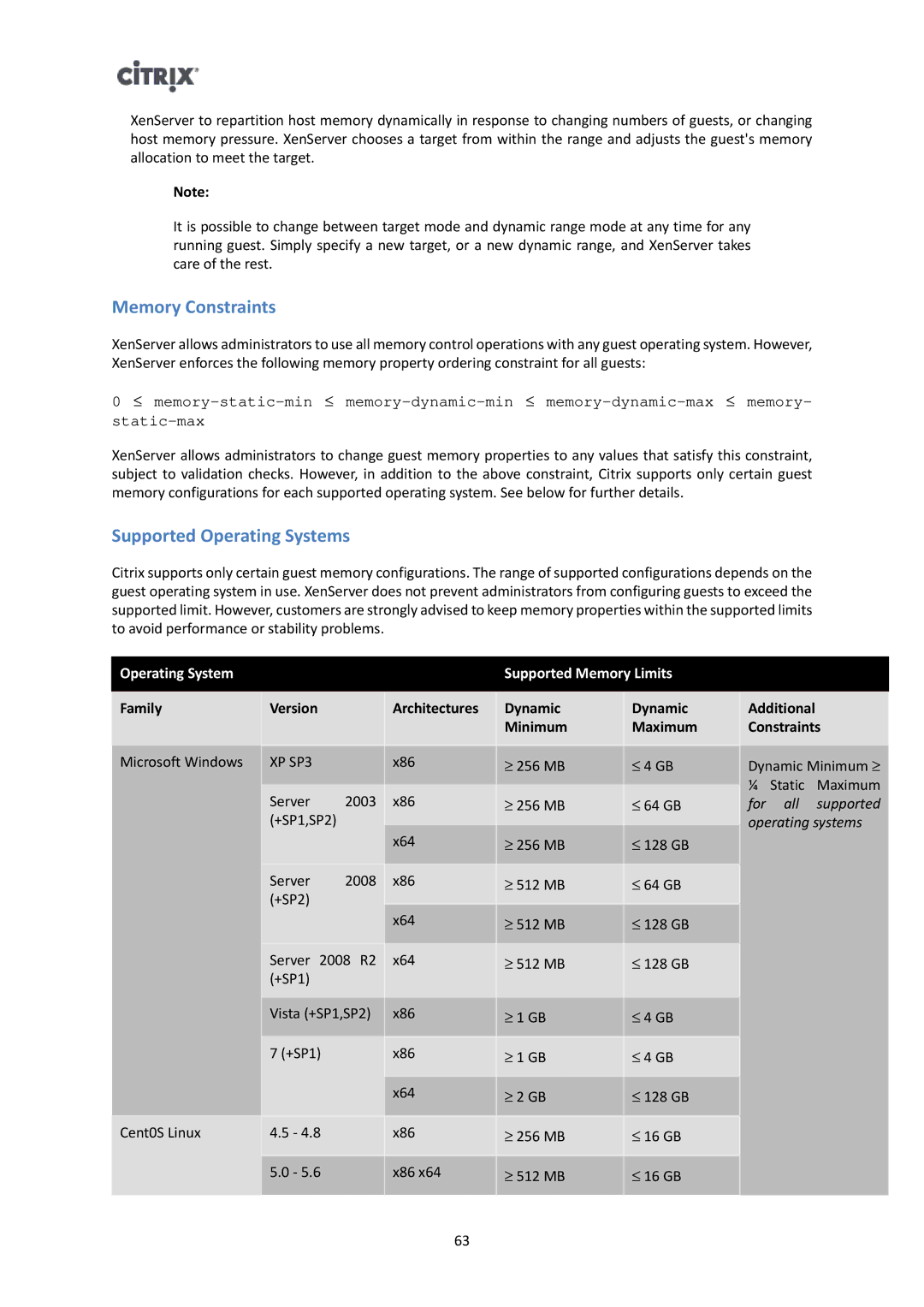XenServer to repartition host memory dynamically in response to changing numbers of guests, or changing host memory pressure. XenServer chooses a target from within the range and adjusts the guest's memory allocation to meet the target.
Note:
It is possible to change between target mode and dynamic range mode at any time for any running guest. Simply specify a new target, or a new dynamic range, and XenServer takes care of the rest.
Memory Constraints
XenServer allows administrators to use all memory control operations with any guest operating system. However, XenServer enforces the following memory property ordering constraint for all guests:
0 ≤
XenServer allows administrators to change guest memory properties to any values that satisfy this constraint, subject to validation checks. However, in addition to the above constraint, Citrix supports only certain guest memory configurations for each supported operating system. See below for further details.
Supported Operating Systems
Citrix supports only certain guest memory configurations. The range of supported configurations depends on the guest operating system in use. XenServer does not prevent administrators from configuring guests to exceed the supported limit. However, customers are strongly advised to keep memory properties within the supported limits to avoid performance or stability problems.
Operating System |
|
|
| Supported Memory Limits |
|
|
| |
|
|
|
|
|
|
|
| |
Family | Version |
| Architectures | Dynamic | Dynamic | Additional |
| |
|
|
|
| Minimum | Maximum | Constraints | ||
|
|
|
|
|
|
| ||
Microsoft Windows | XP SP3 |
| x86 | ≥ 256 MB | ≤ 4 GB | Dynamic Minimum ≥ | ||
|
|
|
|
|
| ¼ | Static | Maximum |
| Server | 2003 | x86 |
|
| |||
| ≥ 256 MB | ≤ 64 GB | for | all | supported | |||
| (+SP1,SP2) |
|
|
| operating systems | |||
| x64 | ≥ 256 MB | ≤ 128 GB | |||||
|
|
|
|
|
| |||
|
|
|
|
|
|
|
|
|
| Server | 2008 | x86 | ≥ 512 MB | ≤ 64 GB |
|
|
|
| (+SP2) |
|
|
|
|
|
|
|
|
|
| x64 | ≥ 512 MB | ≤ 128 GB |
|
|
|
|
|
|
|
|
|
|
|
|
| Server | 2008 R2 | x64 | ≥ 512 MB | ≤ 128 GB |
|
|
|
| (+SP1) |
|
|
|
|
|
|
|
|
|
|
|
|
|
|
| |
| Vista (+SP1,SP2) | x86 | ≥ 1 GB | ≤ 4 GB |
|
|
| |
|
|
|
|
|
|
|
| |
| 7 (+SP1) | x86 | ≥ 1 GB | ≤ 4 GB |
|
|
| |
|
|
|
|
|
|
|
|
|
|
|
| x64 | ≥ 2 GB | ≤ 128 GB |
|
|
|
|
|
|
|
|
|
|
| |
Cent0S Linux | 4.5 - 4.8 | x86 | ≥ 256 MB | ≤ 16 GB |
|
|
| |
|
|
|
|
|
|
|
| |
| 5.0 - 5.6 | x86 x64 | ≥ 512 MB | ≤ 16 GB |
|
|
| |
|
|
|
|
|
|
|
|
|
63
